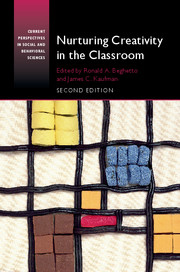Preface
Published online by Cambridge University Press: 24 November 2016
Summary
The first edition of Nurturing Creativity to the Classroom was published in 2010. Although less than a decade has passed, much has happened in the worlds of education and creativity. We've seen the Common Core Standards implemented in many states, eliciting emotional reactions both in favor of and against these ideas. The classroom (and world) has become increasingly digital; it is easier than ever to access information, communicate ideas, and learn from people across the world. New voices have emerged and new research and theories have added to the discussion.
We have also seen interest in creativity explode over the past few years. Creativity has become an international educational priority. Many countries have included cultivating creativity in their national educational policy recommendations. This recognition of the importance of creativity has also come with increased concern that many schools are ill-equipped to nurture students' creative potential. In fact, the notion that schools “kill creativity” has become a widespread social meme. We view such beliefs as both hyperbolic and problematic. Although it is true that some educational contexts might suppress students’ willingness to take the risks necessary for creativity, schools can't really kill creativity. Indeed, opportunities for supporting creativity are ever-present. Often what is needed is simply recognizing and capitalizing on those opportunities.
The ideas shared in the new addition of this book have the goal of helping educators and researchers nurture creativity in K–12 and college-level classrooms. The chapters in this edition represent a blend of old and new. Some of the chapters are updated from the first edition, some are vastly rewritten, and some are brand-new chapters written expressly for the second edition. We also have four new brief essays to open the book from educators working in the field who have accomplished remarkable feats at incorporating creativity into the classroom. The book concludes with a rewritten coda of both classic and new take-home points.
As we wrote in the first preface, we have dual roles of being professors and fathers. As we have watched Olivia, Jacob, and Asher explore and develop their own creativity, the importance of an educational system that values creativity has become increasingly salient. Our children have an advantage in that their fathers value creativity (perhaps too much!).
- Type
- Chapter
- Information
- Nurturing Creativity in the Classroom , pp. ix - xPublisher: Cambridge University PressPrint publication year: 2016

